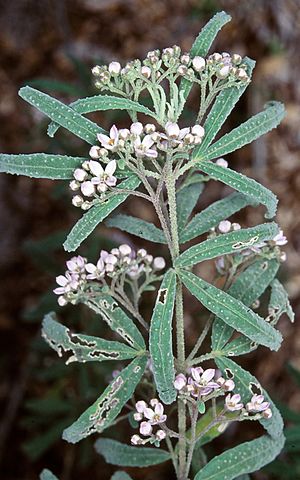Box Range zieria facts for kids
Quick facts for kids Box Range zieria |
|
|---|---|
 |
|
| Zieria buxijugum in the Australian National Botanic Gardens | |
| Conservation status | |
| Scientific classification | |
| Genus: |
Zieria
|
| Species: |
buxijugum
|
The Box Range zieria (scientific name: Zieria buxijugum) is a special plant. It belongs to the citrus family, called Rutaceae. This plant is found only in a small area on the south coast of New South Wales, Australia. It is a bushy, rounded shrub. It has soft, velvety leaves that look a bit like clover and smell very strong. In early spring, you can see many small white flowers with four petals. They grow in big groups near the ends of its branches.
Contents
What the Box Range Zieria Looks Like
The Box Range zieria is a thick, rounded shrub. It usually grows about 2 to 3.5 metres (6.5 to 11.5 feet) tall. Its branches have small bumps, like warts, and are covered with short hairs.
Leaves
The leaves grow in pairs on opposite sides of the stem. Each leaf is made up of three smaller parts called leaflets. The middle leaflet is shaped like a narrow spear. It is about 10 to 30 millimetres (0.4 to 1.2 inches) long. It is also 2 to 3 millimetres (0.08 to 0.12 inches) wide. The stalk that holds the leaflet is 2 to 5 millimetres (0.08 to 0.2 inches) long. The other two leaflets are similar but a little shorter. All the leaflets are a dull grey-green colour. They feel velvety and have small, warty bumps. If you crush them, they have a very strong smell.
Flowers
This plant produces many white flowers. Each flower is about 6 to 7 millimetres (0.24 to 0.28 inches) across. They grow in clusters of 10 to 16 flowers, sometimes even up to 28. These clusters grow where the leaves meet the stem. The stalk holding the flower cluster is hairy and warty. It is usually 4 to 10 millimetres (0.16 to 0.4 inches) long. There are one or two small leaf-like parts, called bracts, at the base of each cluster.
The sepals, which are small leaf-like parts under the petals, are triangular. They are less than 1 millimetre (0.04 inches) long and covered with soft hairs. The four petals are egg-shaped. They are about 4 millimetres (0.16 inches) long and 2 millimetres (0.08 inches) wide. The underside of the petals is very hairy, while the top has fewer hairs. Inside the flower, there are four stamens. These are the parts that produce pollen. Their tips, called anthers, are orange-red.
Flowering and Fruit
The Box Range zieria mainly flowers in September. After the flowers bloom, they turn into a fruit. This fruit is a capsule, which is a dry seed pod. It is mostly smooth.
Naming the Box Range Zieria
The scientific name Zieria buxijugum was first officially described in 2002. It was named by two scientists, John Briggs and James Andrew Armstrong. They studied a plant sample found west of Pambula. Their description was published in a science journal called Australian Systematic Botany.
The second part of the name, buxijugum, comes from two Latin words. Buxus means "wood," and jugum means "ridge" or "mountain top." This name likely refers to where the plant was found.
Where the Box Range Zieria Lives
The Box Range zieria is only found in one specific place. It grows on a rocky area on private land west of Pambula. This makes it a very rare plant.
Protecting the Box Range Zieria
The Box Range zieria is a plant that needs our help to survive. It is listed as "Critically Endangered" in New South Wales. This means it is at very high risk of disappearing from the wild. The Australian government also lists it as "Endangered."
When it was first found in 1986, there were 68 plants. By the mid-1990s, this number dropped to 40. In 2001, only 32 mature plants were left. To help protect them, wire mesh fences were put up. These fences stopped swamp wallabies from eating the plants. By 2016, the number of plants had grown to 130.
The main dangers to this plant are wallabies eating them. Also, if the land where they grow changes ownership in the future, it could affect their safety. Protecting this small area is very important for the survival of the Box Range zieria.


